|
The bad state of poor people's
health in the early 19th century can be seen by the
prevalence of hernias caused by their hard lifestyle. In 1814 a Truss Society was
founded, which spent about £140 a year on trusses for
poor people, raised by voluntary subscription.
On the 30th of January, 1817, a
general meeting at the Town Hall resolved unanimously
that soup should be given twice a week to the
inhabitants of the workhouse instead
of meat. |
|

Priory Hall. From an old postcard.
|
| Priory Hall was built in 1825 by John William Ward,
the Earl of Dudley, as a family residence in the town,
but was later occupied by his chief land and mine agent.
The most famous resident was Sir Gilbert Henry Claughton,
a businessman and politician who was the son of the Reverend Thomas Leigh Claughton,
Bishop of St Albans. His mother, Julia Susannah Ward,
was the elder daughter of the 10th Baron Ward of Dudley. |
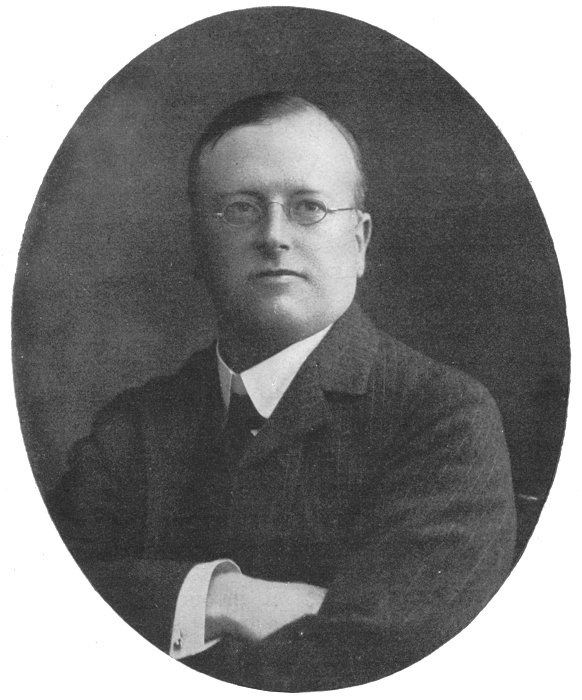 |
Sir Gilbert Henry Claughton. |
|
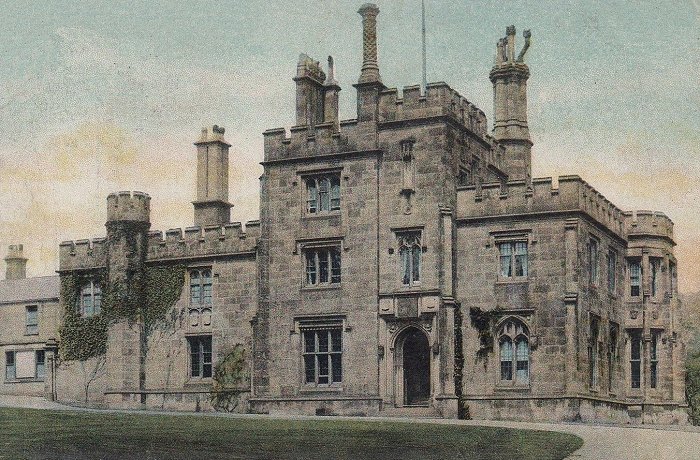
Another view of Priory Hall.
From an old postcard. |
| Gilbert was educated at Eton and King's College,
London, before beginning an apprenticeship at Beyer,
Peacock & Company, Manchester-based locomotive builders.
In 1884 he moved to the Earl of Dudley's Castle Mill
Works, then became the Mineral Agent for the Dudley estate
in 1891.
He moved into Priory Hall where he lived
with his sister. At various times he was a director of a
number of companies including Round Oak Works, Barclays
Bank, the South Staffordshire Water Works Company, and Mond Gas Works.
Gilbert was Mayor of Dudley between 1891 and 1894 and
one of the original members of Staffordshire County
Council. Between 1895 and 1921 he was an Alderman of the
council and in 1906 stood unsuccessfully as a
Conservative Member of Parliament for Dudley. He was
defeated by the Liberal candidate, Arthur George
Hooper who received 8,296 votes to Gilbert
Claughton's 7,542 votes. In 1905 he became a director of
the London & North Western Railway and from 1911 to 1921
became Chairman of the railway company. In 1913 a class of
express locomotives, The Claughton Class was named after
him. |
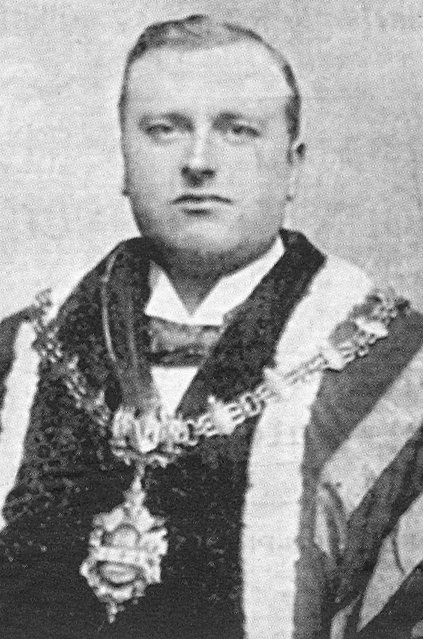
Gilbert Claughton in his
mayoral robe. |
|
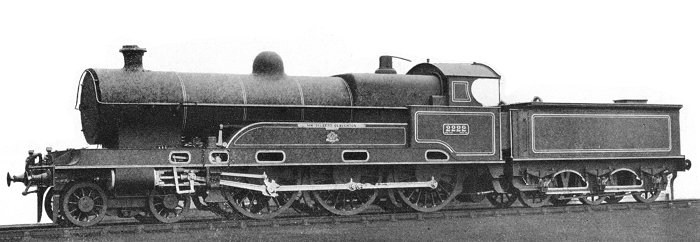
The first Claughton Class
locomotive, which carried the name Sir Gilbert Claughton. |
| Sir Gilbert was created a baronet, of The Priory in
the Parish of Dudley, on the 4th July, 1912, but the
hard work that resulted from his many interests finally
caught up with him. In 1921 he resigned from the
chairmanship of the London & North Western Railway after
suffering from a breakdown and went to stay with his
widowed sister in St. Briavels Castle, that overlooks
the River Wye, and is now a hotel. Sadly he never
recovered and died at the castle on the 27th June, 1921,
at the age of 65. The town of Dudley went into
mourning and a funeral service was held at St. Edmund's
Church. He was buried in the private burial ground
behind the church at Himley, reserved for the Earls of
Dudley and family members.
In 1930 a large working model of the locomotive Sir
Gilbert Claughton was presented to Dudley Corporation by
the London, Midland and Scottish Railway, the successors
to the London and North Western. For many years it was
on public display in Dudley library. In 1966 when the
library was refurbished, the model was taken to the Sir
Gilbert Claughton School for safe keeping. It was never
returned and its whereabouts are unknown.
In 1926 Priory Hall was
acquired by Dudley Borough Council and later housed the
surveying department. It is now Dudley Register Office
and along with Priory Park is Grade II listed. |
| |
|
|
|
|
Read about
local railways |
 |
|
Read about
local canals |
 |
| |
|
|
|
|
|
The population of Dudley, as listed in
the 1831 census was 23,043.
In 1832 during the cholera
epidemic, St. Thomas's Church announced that a
collection would be taken for those suffering from
cholera and a list of subscriptions given by private
individuals in order to provide the poor with wholesome
food and other comforts during the epidemic, was
published. During the epidemic, St. Thomas's churchyard
was so full that the dead had to be taken to Netherton
Church. There were 1,124 cases of the disease and 277
deaths. The outbreak in 1848 was much worse. Between
August and November of that year, there were 412 deaths
from cholera in the town, and in 1853 a further 256
people died from the disease. |
|

A poster from 1832. |
| Pure water first came to Dudley in 1834 thanks
to a special act of Parliament that gave the water
company powers to provide a clean supply. People had
been forced to steal water, that was often infected.
This resulted in Dudley having the highest death rate
in the country. In 1852 the average age of death was 16
years 7 months, and 69.8 percent of people died before
the age of twenty. In 1836 the Dudley Poor Law Union
was established. Previously relief of the poor had been
administered by the church and private benefactors.
Dudley's first parliamentary
election in December 1832 was won by Sir John
Campbell, who was Solicitor-General in Lord Grey's
Whig government. He was defeated in the next
election on the 27th February, 1834 by Thomas Hawkes.
Dudley Poor Law Union, formed
on the 14th October, 1836 was overseen by an elected
Board of Guardians. There were 27 of them,
representing the parishes of Dudley, Sedgley,
Tipton, and Rowley Regis. The number of guardians
representing each parish were as follows: Dudley -
10, Sedgley - 8, Tipton - 6, and Rowley Regis - 3.
Initially the original workhouses at Dudley, Sedgley
and Tipton continued in use.
Dudley’s old workhouse had become
too small for the increasing number of inmates.
Overcrowding was leading to awful living conditions and
so work on a new workhouse for 842 inmates began in 1855
to 1856, in Wolverhampton Road, now Burton Road. After
completion in 1859, the inmates from the other
workhouses in the union were transferred to
Wolverhampton Road,
and the other buildings were disposed of. |
|
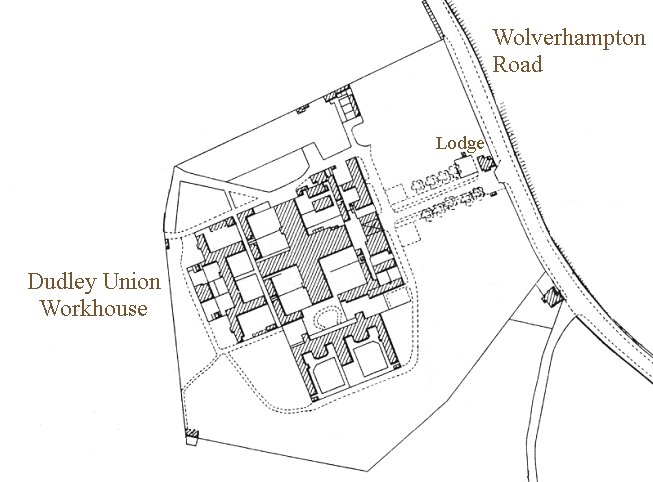
The new workhouse in
Wolverhampton Road. |
| The new workhouse had separate wings for
males and females, able-bodied or infirm, a
block for children and an infirmary. There was
also a master’s office, a board room for
meetings of the Board of Guardians, a clerk’s
office, and a room with a bed and bath to
prepare inmates in readiness to see the doctor. Everywhere was spotlessly clean and
well-ventilated. The beds in the wards were made of
straw with a separate blanket and a quilt. A fireplace
was at the end of each room and there were wards for
couples over the age of 60, an old woman’s day room, a
ward for young childless women, a nursery ward, a boy’s
and girl’s dining room catering for about 120 people of
both sexes, entering and leaving at different sides of
the room, a laundry, drying and washing rooms,
and schoolrooms with dormitories over the top. Separate sick rooms for males and
females included idiot wards, bad leg wards, general
sick wards, asthma and bronchial sick wards, and a
surgery.
There was also a cooking kitchen with
steam-cooking machines, a general dining room for
able-bodied adults where they were summoned to meals
three times a day, by a bell, and store rooms for food etc. Up to 20 men a day were engaged in
breaking stones.
In 1881 the staff in the Dudley Union Workhouse
consisted of the master of the workhouse, a matron of the
workhouse, an assistant master of the workhouse, an
assistant matron of the workhouse, five nurses, a cook,
a porter, a laundress, a school master, a school
mistress, and a servant. There were 754 residents.
The workhouse later became Burton
House Public Assistance Institution, and later, Burton
Road Hospital. The old workhouse buildings have long
disappeared. |
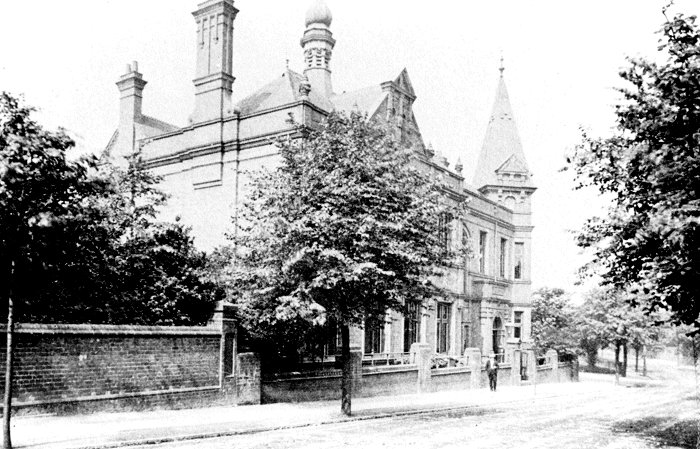
The offices of the
Board of Guardians, number 7 St. James's
Road, built in 1888. The building still
survives and is used by Dudley Council. From an old postcard. |
|

From Michael Billing's
1855 Directory. |
|
In 1853, Dudley came under the
control of the Board of Health, which survived until
1865. It was set up because the Town Commissioners had
failed to remedy the intolerable health conditions in
the Town. The Town Commissioners were angry at being
replaced and the Clerk to Board of Health reported on
several occasions that the Clerk to the Town
Commissioners had refused to hand over their minutes and
other archives.
The Board of Health took its duties
seriously and appointed several active sub-committees
which met regularly. In 1855 they included a Finance
Committee, a Health Committee, an Improvements, Lighting
and Cleansing Committee, a Surveys and Public Works
Committee and a General Purposes Committee. There were
five chief officers to execute its decisions: the Clerk,
the Surveyor, the Inspector of Nuisances, the Inspector
of Lodging Houses and the Officer of Health.
The Board of Health was able to
boast that in 1855 it had reduced the death rate since
1852 by one third, which was a formidable achievement.
The last surviving Minute Book, which is from 1863
provides an insight into the Board's activities. The
expenditure in September included the following:
£15.1s.6d. was spent on the highway rate account,
£117.4s.0d. from
the Lighting Account, was paid to the Dudley
Gas Light Company for one quarter's supply of gas for
220 lamps, along with £21 for 28 lamps in the outer
areas. The Inspector of Nuisances spent £4.16s.0d.
The Board of Health was superseded
by the newly incorporated Borough Council in 1865 and
local government began to assume the character of a
large scale organisation. The charter of incorporation,
granted on the 3rd April 1865, divided the
borough into seven wards: St. Thomas's Ward,
Castle Ward, St. Edmund's Ward, St. James'
Ward, St. John's Ward, Netherton Ward and Woodside
Ward. The council
consisted of the mayor, ten aldermen and thirty
councillors.
In 1865 Frederick Smith, the first
municipal Mayor, provided entertainment in the castle
grounds for local children and in 1875, Joseph Stokes,
Mayor, issued a circular letter on the terrible slums
that still survived at the time.
By1868 there was a gradual
improvement of health services and people’s
health. The first Commission of the Peace was
granted in 1867, and in 1888 Dudley became a
County Borough, under the provisions of the
Local Government Act, 1888. |
|
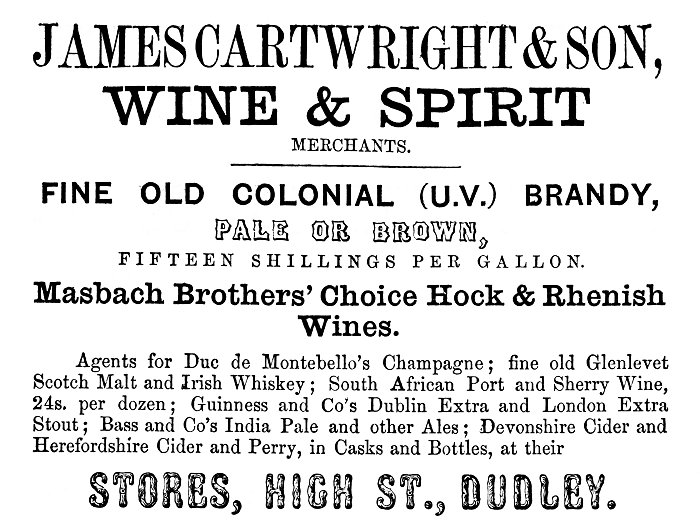
An advert from 1861. |
| |
|
|
|
|
|
Excerpts from
Michael Billing's
1855 directory |
 |
|
An 1861 list
of trades men and trades women |
 |
| |
|
|
|
|
|
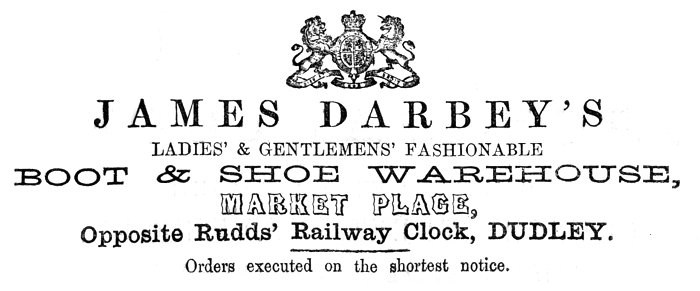
An advert from 1861.
|
|
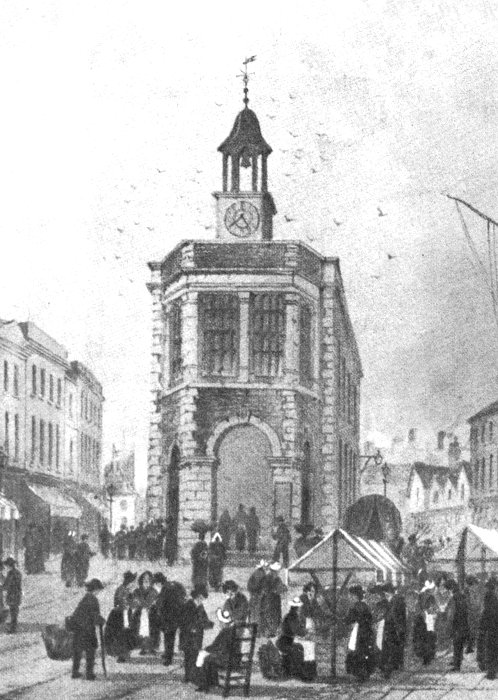
The old Town Hall. From an old
postcard. |
Dudley’s old town hall in the
market place was demolished in 1860 after falling into a
sad state of repair.
The arches provided a useful
space beneath for use by market traders.
It was later used as a
police station and a magistrate’s court, but eventually
it became an eyesore. |
| On the 17th October, 1867, the fountain in
the market place was officially opened. The
market had been paved and a cab stand was erected. The fountain was given to the
town by the Earl of Dudley and his wife, who drank the
first water from the fountain in a specially engraved
goblet. The Earl wanted to encourage temperance and so
he had the water fountain built. It was designed by
James Forsyth who had designed the Perseus Fountain at
Whitley Court, where the Earl lived. In the 1980s the
water supply was cut-off and the bowls were filled with
concrete. |
|
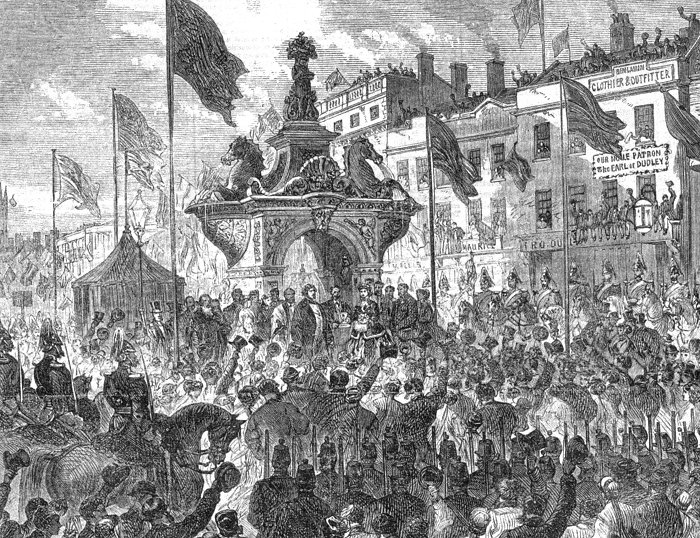
The opening ceremony from the
Illustrated London News. |
|
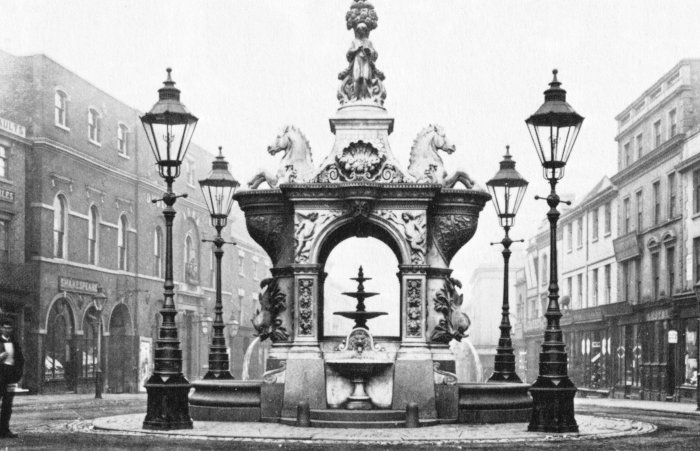
A fine view of Dudley's lovely
market fountain. From an old postcard. |
|
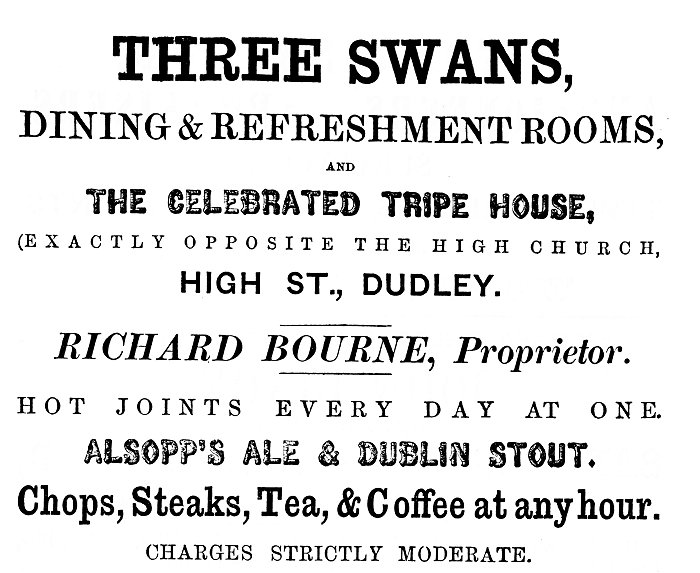
An advert from 1861. |
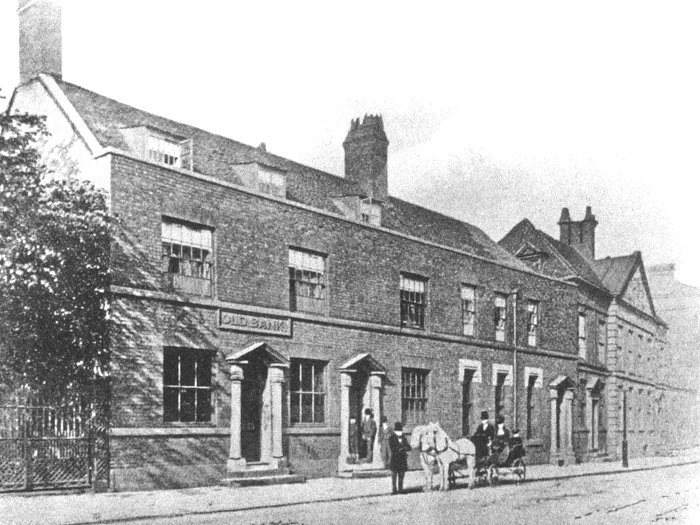
Dudley Old Bank in
Wolverhampton Street, built in 1791, was taken
over by Lloyds Bank in 1866. The original
building was demolished and replaced by the
building below in 1876. From an old postcard. |

Dudley Old Bank in Wolverhampton Street,
as it is today. The bank closed in 2005 and
was converted
into the apartments, seen above. |
| Early attempts at fighting fires began in 1834,
but they were ineffective. On the 6th May, 1834, it was
ordered that a place be acquired for storing Fire
Engines and that Richard Paskin, be appointed as
engineer to take care of them at an annual salary of
eight pounds. Also that twelve firemen be paid the
sum of one pound each per year. In the 1870s and
1880s the Borough Council purchased the town’s first
fire engines which were used by the first fire brigade,
consisting of the town’s police constables. Early fire
stations were based at the police stations in Netherton,
Woodside and Kates Hill. In 1892 the town's fire
station was built in Priory Street next to Stone
Street Square which was used by market traders and
became the town's fish and vegetable market. The
site occupied by the fire station had previously
been occupied by Dudley Flint Glass works,
constructed around 1770. In 1898 Dudley purchased a Shand Mason steam fire engine.
The Superintendent of the Fire Brigade in 1900 was
Richard Speke, who managed the town's 10 firemen. |
|

Priory Street fire
station during construction. |

An ox-roast at
Stone Street Square. The small
building in the background is the
Public Weighbridge Office which
closed in 1967. From an old
postcard. |
| The Priory Street fire station
continued in use until 1939, when a new
fire station was built in Tower Street.
The new fire station closed in 1998 and
was later acquired by Dudley College.
The current fire station is in Burton
Road. The site of the fire station in
Priory Street was used as a club for the
RAF, Payne’s shoe shop and later
Carver’s Cafe. It is now the Old Glass
House, restaurant and bar. |
|
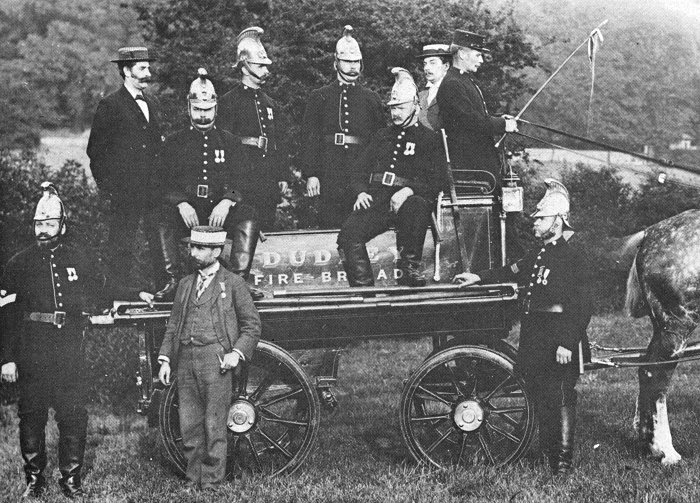
Dudley Fire Brigade in
1901. |
|

Priory Villa on the corner
of Ednam Road and Priory Road. Also known as
Kudos House. |
| Priory Villa was built in 1865 for John Hyde
Houghton, the surgeon in charge of Dudley
dispensary, which was built around the same
time, and has since been demolished. It stood in
Priory Road on the corner of Ednam Road,
opposite Priory Villa. The house was home to the
Houghton family, but also contained the
surgeon's consulting rooms. There are two
entrances, one in Ednam Road, leading to the
family's residence, and the other in Priory Road
for the use of patients. Mr. Houghton
specialised in obstetrics and was also a
Worcestershire county magistrate. Ednam Road
and Priory Road were built in the 1870s, as part
of Lord Dudley's Priory Fields development.
Priory Villa remained as a family home until it
was acquired by Dudley Council in the 1960s and
is now part of Dudley College. It was Grade II
listed on the 25th November, 2010.
|
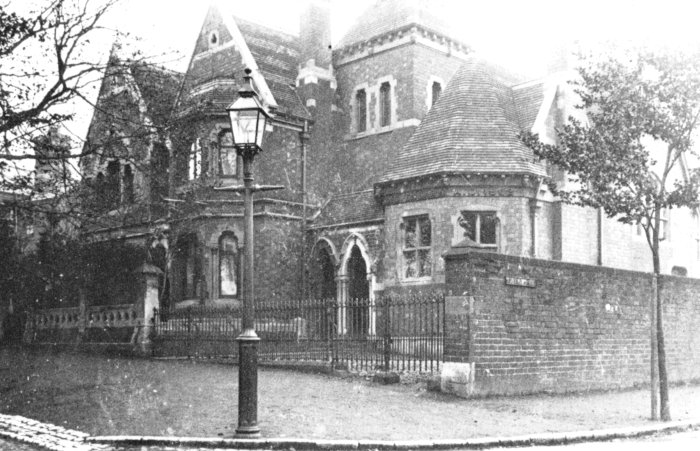
Dudley dispensary in
Priory Road, was a charitable institution
for the relief of poor sick people. In 1892
there were over 5,500 patients attending
annually. When the National Health Service
was established, it became the headquarters
of the District Nursing Service, then in
1957 council offices. It was demolished in
1975. From an old postcard. |
|
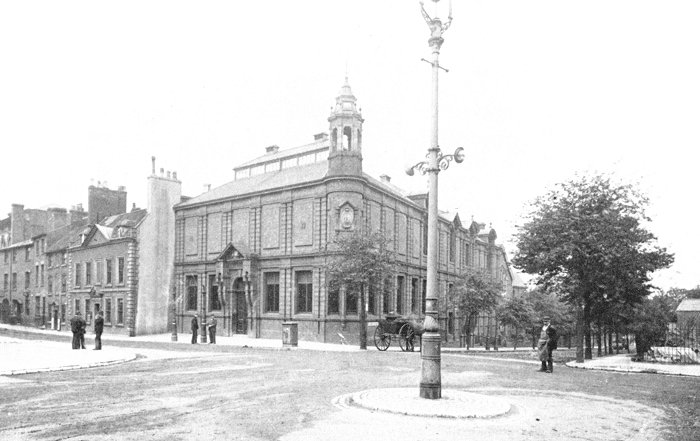
Dudley's old museum and art
gallery. From an old postcard. |
| Dudley's old museum and art gallery on the
corner of Priory Street opened in 1884 as the
library, art gallery and school of art. The school
of art moved to Dudley Technical College in 1966.
The foundation stone was laid by Earl Beauchamp, the
Lord Lieutenant of Worcestershire, on Tuesday the
3rd July, 1883. The building was designed to
house a large reading room, a library capable of
holding 5,000 books and an art gallery. The rooms
upstairs were to be used by the Dudley School of
Art. The library and art gallery was built by Webb
and Round from Dudley, at a cost of £5,300.
The building was officially opened on the 29th July, 1884,
by Mrs. Claughton, the Earl of Dudley's sister. The
free library was paid for from a one penny rate
which allowed Charles F. Mackmain to be appointed as
librarian, on a salary of £100 a
year. It became extremely
popular, so much so that 50,000 books were issued in
1889 and overcrowding became a problem. This led to
the building of a larger library across the road in
St James's Road, which opened in 1909.
The art gallery wasn't initially very popular, it
contained few pieces of art. On Mondays and
Saturdays entrance was free, but on Wednesdays and
Fridays there was a charge of three pence. It became
quite popular on the days when the entrance was
free, but few people were willing to pay the
admission fee, which was eventually dropped.
Exhibitions were held there, particularly by the
Dudley Art Circle, founded in 1928 which held an
annual exhibition. Visitor numbers continued to
increase and reached 18,888 in 1938.
During the Second World War the building was
closed, but from 1946 it opened daily from 10am to
8pm.
In January 1965 the geological gallery opened on
the ground floor to display the
collection of fossils given
by the former Dudley Geological
Society. |
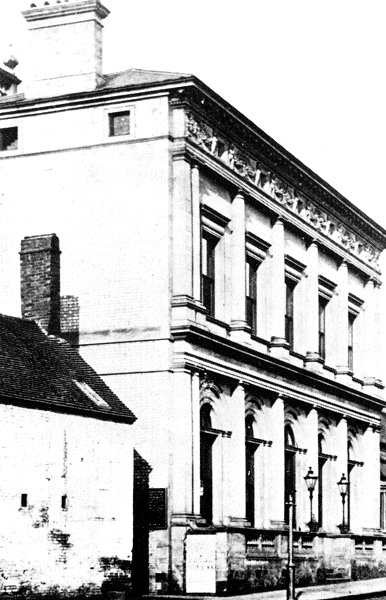 |
The Mechanics
Institution , later called the Dudley Institute
was founded in 1848 to provide classes, lectures
and concerts. The
institute's building stood in Inhedge, alongside
Wolverhampton Street and opened in 1863.
It contained
classrooms, a public hall, a reading room and
Dudley Geological Society's museum.
It was funded by the
popular Dudley Castle fetes.
From an old postcard.
|
|
The School of Art, which was housed above the
library was partly funded by additional duty imposed
on wines and spirits that allowed an art master be
appointed along with free tuition for selected
pupils. In 1901 the School came under the control of
the Borough Council. In 1909 a pottery room was added when the
library moved across the road. In 1946 because of
the wish to extend the viewing galleries, it was recommended that
the school should move to, and
become part of the Technical School, which
happened in 1966.
In the mid 1970s when the Black Country Living
Museum was established, the industrial collection
moved there.
In November 1981, the Brooke
Robinson Collection was
re-displayed in the gallery after a gap
of 15 years.
In 2016, the decision was made
to close the Museum and
Art Gallery as part of a
cost-cutting exercise and re-display some
of the collection in the new
Dudley Archives building in Tipton Road, which has
become Dudley Archives and Local History Centre. The
Priory Street building closed to the public on the
22nd December, 2016. |
| The Conservative Club The large
Georgian house in Castle Hill, next to St.
Edmund's Church, was built in about 1790 and
was home to Dudley's veterinary inspector,
Abraham Green, who had a vets shop at 44 and 45 King Street,
which he ran with his son. They later opened a
second shop in New Mill
Street. The listing below is from Kelly's
1912 Worcestershire Directory.
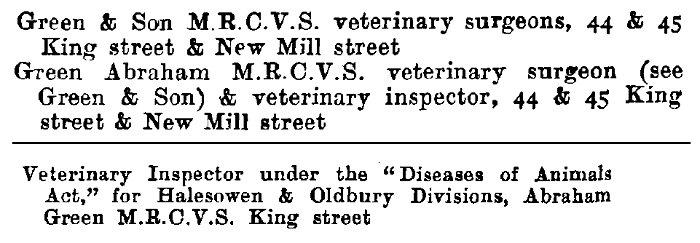
In 1884 the building was
acquired by Dudley Conservative Club and
officially opened in October, 1884. The
building was Grade II listed on the 14th
September, 1949. It is now King Charles
House Business Centre. |
|
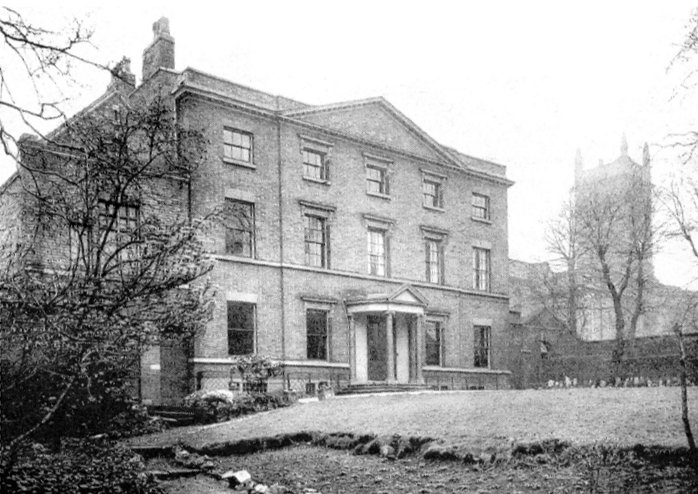
The Conservative Club. |
|

Dudley Conservative
Club lounge. |
|
The Conservative
Club had another property in the centre
of Dudley, Priory House, at number 2
Priory Road, opposite the Council House.
It was built in the early 1800s and is
clearly marked on a map, produced in
1824. For almost 100 years it was a
private residence. In 1880, George
Thompson moved there. He is listed in
Kelly’s 1892 Directory of Worcestershire
as: George Thompson, Priory House,
Priory Road.
The Conservative
Working Men’s Club was based at 60 Tower
Street, in a rented building that was
far too small. The club planned to buy
the property along with an adjoining
property, that would become an
extension. The main objection to this
was that there was no available land for
outdoor recreation, so when the lease
for Priory House, held by Mr. William H.
Thompson, came to an end and the
property was offered for sale, the club
jumped at the opportunity, particularly
because it was a larger building with
extensive grounds.
The club purchased
the building, which was considerably
extended, with the addition of a three
storey building at the rear. Other
additions included an entrance lobby, a
new staircase, a billiard room, a
bowling alley, a large smoke room and
bar, a dining room, a reading room, a
committee room, a card room and a
caretaker’s apartment.
In the 1990s the
building was sold and has since been
converted into office accommodation and
a function room. |
|
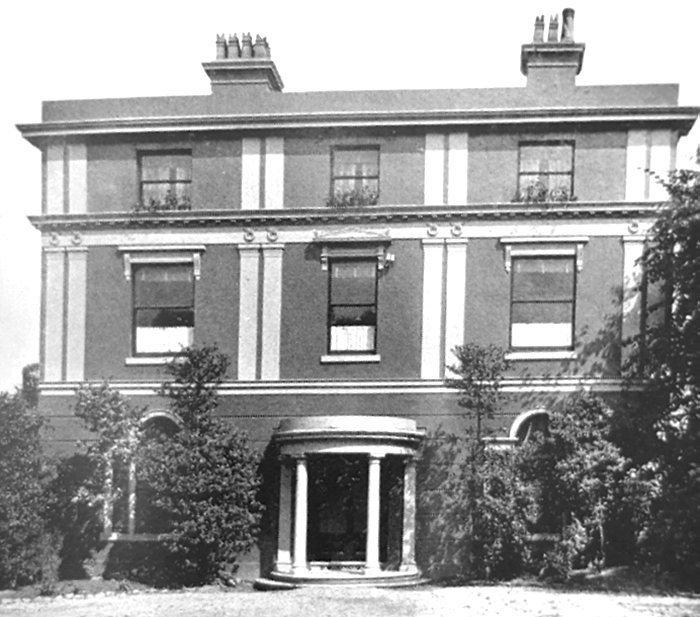
Priory House. |
| |
|
|
|
|
Read about Roads
and Turnpikes |
 |
|
Read about the
Stage Coach Era |
 |
| |
|
|
|
|
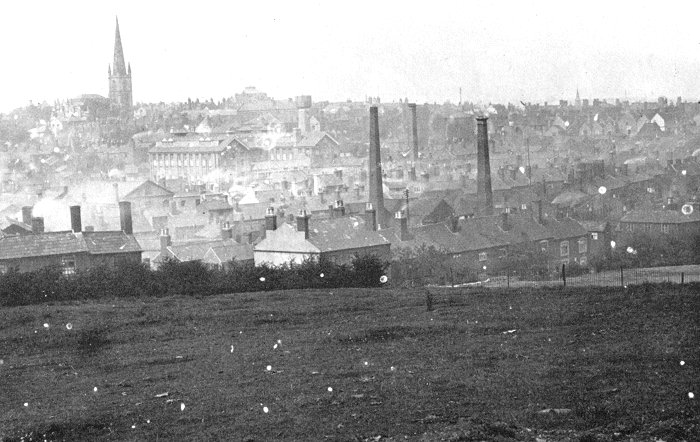
A view of Dudley from the
1890s showing the densely built-up houses and
factories, seen from Prospect Row. From an old
postcard. |
|
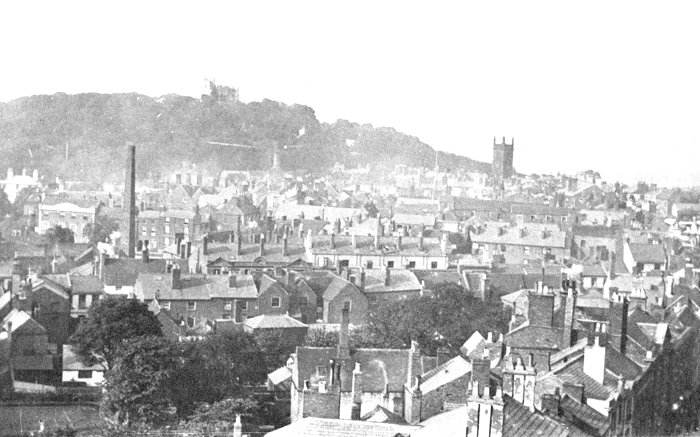
A view of
Dudley in the 1890s, seen from St. Thomas's Church. From an old postcard.
|
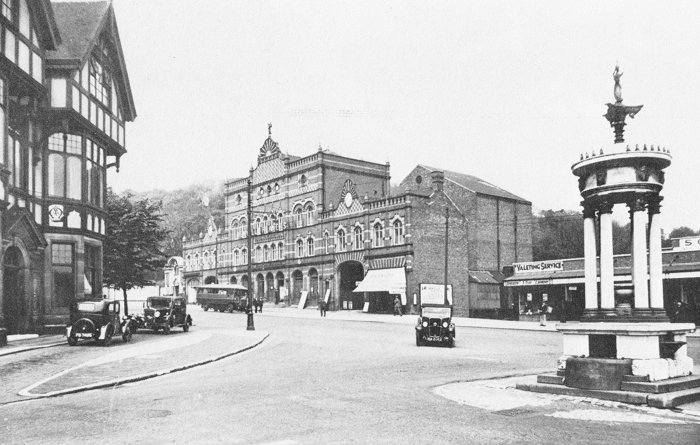
The Opera House at Castle Hill
opened on the 4th September, 1899 with a performance of
‘The Mikado’ by the D’Oyly Carte Opera Company, which was a
great success. The theatre was founded and managed by
John Maurice Clement. Unfortunately the theatre was
destroyed in November 1936 during a fire. From an old
postcard. |
|

Dudley's Boer War Memorial.
From an old postcard. |
Dudley's Boer War memorial in Dudley Cemetery,
Stourbridge Road, is topped by a statue of a soldier
wearing a slouch hat, holding a rifle, with a fixed
bayonet, defending a wounded bugler. The memorial
includes 56 names of the local people who died in
the war, listed by rank, surname, forename and
manner of death.
It was unveiled on the 23rd September, 1904 by
Lieutenant-General Sir N. G. Lyttleton and was
designed and sculpted by Mr. Henry Owen Burgess, who
studied at Dudley School of Art.
The memorial was Grade II listed on the 16th May,
2016. |
|
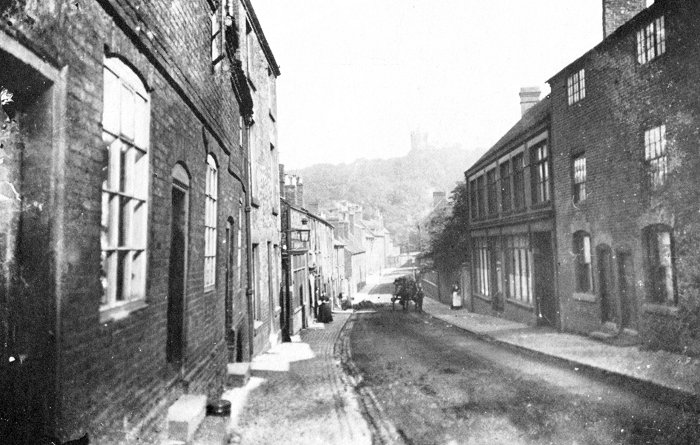
An early view of Tower Street.
From an old postcard. |
|
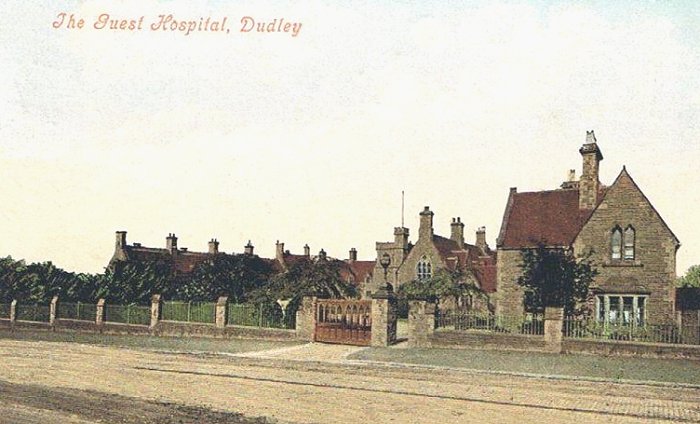
A view of the Guest Hospital and
Tipton Road. From an old postcard. |
| |
|
| Read
about the Guest Hospital |
 |
| |
|
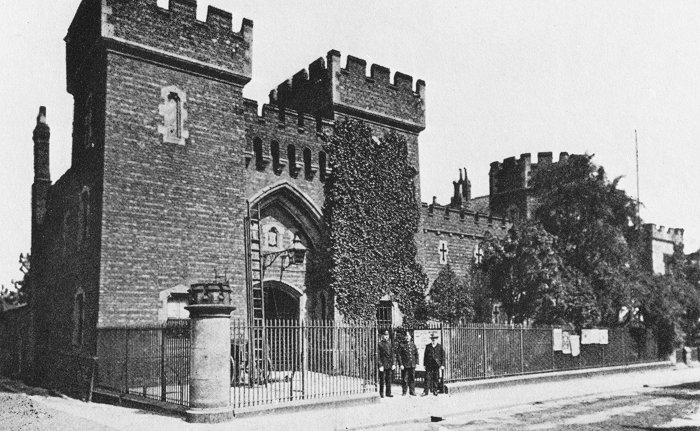
The old police station and
lock-up was built in about 1847 and remained in use
until 1940 when the later police station was built
on the corner of New Street and Tower Street. In
1892 the Chief Superintendent was Henry Burton, the
Inspector was Thomas Long, and there were 6
sergeants and 31 constables. Photo from an old
postcard. |
There were several local newspapers. In 1892
there were four:
The Daily Argus, branch office, Castle Street.
Joseph Harris, manager.
The Dudley Herald, 210 Wolverhampton Street. Joshua
Hatton, publisher. Published on Saturdays.
The Evening Star, Wolverhampton Street. Published by
the Midland News Association Limited.
The Midland Evening News, Wolverhampton Street.
Published by Midland Press Limited.In 1900 there
was the Dudley Herald and Wolverhampton based,
Express & Star. |

The County Court in Priory
Street was built in 1858. It has two storeys and an
attic and was Grade II listed on the 9th April,
1976. In 1891 the Judge was William Downes
Griffith B. A. assisted by the
Registrar, William C.
Kettle, and the Deputy
Registrar, George Walton Walker. It covered the
parishes of Dudley, Tipton, Sedgley & Rowley, with four,
or five court days
a month. The building has now been
converted into apartments. |
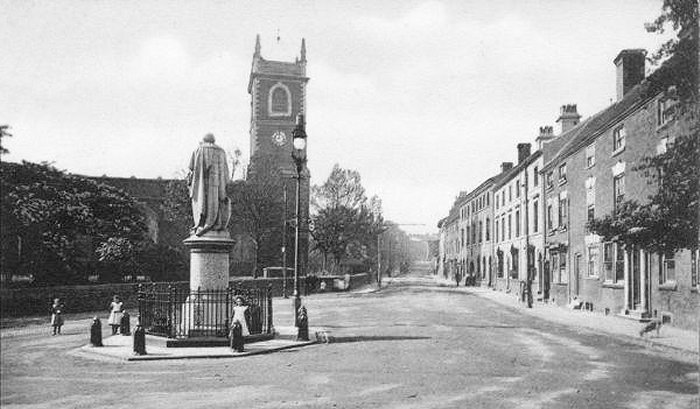
Looking up Castle Street with
the Earl of Dudley's statue on the left and St.
Edmund's Church. The text on the statue includes the
following information: It is in
memory of William Ward, 1st Earl of Dudley (27th
March, 1817 to 7th May, 1885), known as Lord Ward
from 1835 to 1860. He was a British landowner and
benefactor. In 1860 the earldom held by his kinsmen
was revived when he was created Viscount Ednam, of
Ednam in the County of Roxburgh, and Earl of Dudley,
of Dudley Castle in the County of Stafford. From an
old postcard. |
|

Looking towards the statue and
the entrance to Dudley Castle, from Castle Street.
From an old postcard. |
|
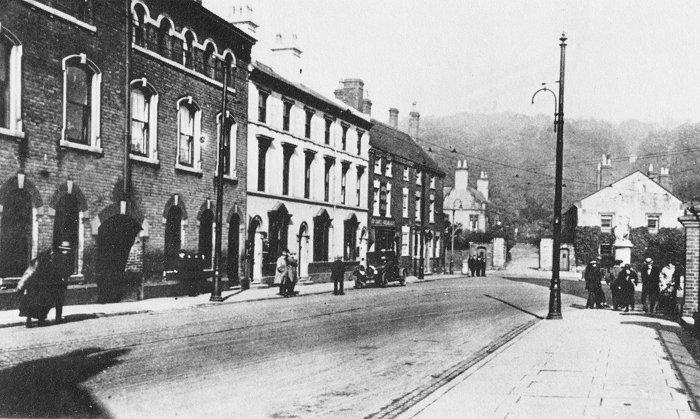
The same view from further
along Castle Street. From an old postcard. |
 |
|
 |
|
 |
Return to the
Eighteenth Century |
|
Return to
the contents |
|
Proceed to Into
the 20th Century |
|